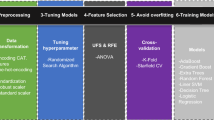Abstract
As the number and impact of online threats increases exponentially, the automatic classification of malware becomes increasingly important in the antivirus business. The heavy use of machine learning in this field raises the following question: “How much will a trained machine-learning model resist in time against the ever-changing malware binary code?” In this paper we present a study of proactivity in malware detection using Perceptron derived algorithms. We gathered an industrial quantity of both malicious and benign files, then we trained a series of classifiers on nine months’ worth of data and discuss the behavior of the obtained models tested on the next fourteen weeks. We conclude with the result analysis and recommendations for the practical use of this technique in real life scenarios.
Similar content being viewed by others
References
Kinder J., Katzenbeisser S., Schallhart C., Veith H.: Proactive detection of computer worms using model checking. IEEE Trans. Depend. Secure Comput. 7, 424–438 (2010)
Berard, B., Bidoit, M., Finkel, A., Laroussinie, F., Petit, A., Petrucci, L., Schnoe-Belen, Ph., Mckenzie, P.: Systems and Software Verification: Model-Checking Techniques and Tools (2001)
Moskovitch R., Feher C., Elovici Y.: A chronological evaluation of unknown malcode detection. In: Chen, H., Yang, C.C., Chau, M., Li, S.-H. (eds) Pacific Asia Workshop on Intelligence and Security Informatics. Lecture Notes in computes Science, vol. 5477, pp. 112–117. Springer, Heidelberg (2009)
Rieck, K.: Computer security and machine learning: worst enemies or best friends? DIMVA Workshop on Systems Security (SYSSEC) (2011)
Momina, S.T., Zubair, S.M., Muddassar, F.: Malware detection using statistical analysis of byte-level file content. In: Proceedings of the ACM SIGKDD Workshop on CyberSecurity and Intelligence Informatics (2009)
Rieck K., Trinius Ph., Willems C., Holz T.: Automatic analysis of malware behavior using machine learning. J. Comput. Secur. 19(4), 639–668 (2011)
Harris, M.: Behavioral Genotype Technology: A New Approach to Proactive Detection of New Malware (2007)
Gavriluţ, D., Cimpoeşu, M., Anton, D., Ciortuz, L.: Malware detection using machine learning. In: International Multiconference on Computer Science and Information Technology-IMCSIT. IEEE, pp. 735–741 (2009)
Spitzner L.: Honeypots: Tracking Hackers. Addison-Wesley, Boston (2002)
Oberheide, J., Bailey, M., Farnam, J.: PolyPack: an automated online packing service for optimal antivirus evasion. In: Proceedings of the 3rd USENIX conference on Offensive Technologies (2009)
Baldi P., Brunak S., Chauvin Y., Andersen C.A.F., Nielsen H.: Assessing the accuracy of prediction algorithms for classification: an overview. Bioinformatics 16(5), 412–424 (2000)
Rosenblatt F.: The Perceptron: A Probabilistic Model for Information Storage and Organization in the Brain. MIT Press, Cambridge (1958)
Author information
Authors and Affiliations
Corresponding author
Rights and permissions
About this article
Cite this article
Cimpoeşu, M., Gavriluţ, D. & Popescu, A. The proactivity of Perceptron derived algorithms in malware detection. J Comput Virol 8, 133–140 (2012). https://doi.org/10.1007/s11416-012-0164-1
Received:
Accepted:
Published:
Issue Date:
DOI: https://doi.org/10.1007/s11416-012-0164-1




